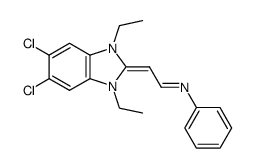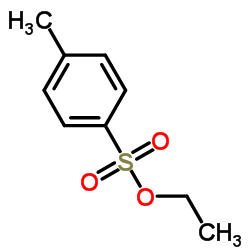JC-1

JC-1 structure
|
Common Name | JC-1 | ||
|---|---|---|---|---|
| CAS Number | 3520-43-2 | Molecular Weight | 652.225 | |
| Density | N/A | Boiling Point | N/A | |
| Molecular Formula | C25H27Cl4IN4 | Melting Point | N/A | |
| MSDS | Chinese USA | Flash Point | N/A | |
Use of JC-1JC-1 is a fluorescent lipophilic carbocyanine dye used to measure mitochondrial membrane potential. |
| Name | 1,1',3,3'-tetraethyl-5,5',6,6'-tetrachloroimidacarbocyanine iodide |
|---|---|
| Synonym | More Synonyms |
| Description | JC-1 is a fluorescent lipophilic carbocyanine dye used to measure mitochondrial membrane potential. |
|---|---|
| Related Catalog | |
| In Vitro | JC-1 (2.5 μM) exposed to murine L1210 lymphoblasts, can be detected the presence of both cytoplasmic JC-1 monomer and mitochondrial J-aggregates in these cells. JC-1 fluorescence is usually excited by the 488 nm laser wavelength common in flow cytometers[1]. Fluorescent labeling of mitochondria with either JC-1 (1 μg/mL, 15 min), reveals that are distributed irregularly, resulting in regions of high and low mitochondrial content within astrocytes[2]. JC-1 has been shown to interact with α-synuclein at the acidic C-terminal region with a Kd of 2.6 μM. JC-1 itself does not accelerate the protein aggregation of α-synuclein in the absence of iron, insted, it decelerates the aggregation process by extending the lag phase approx[3]. JC-1 is avidly accumulated in sensitive K562 cells where it displays both a green cytoplasmic and red mitochondrial fluorescence. JC-1 is poorly accumulated in resistant K562 cells, which displays only a slight green fluorescence[4]. |
| References |
| Molecular Formula | C25H27Cl4IN4 |
|---|---|
| Molecular Weight | 652.225 |
| Exact Mass | 650.003418 |
| PSA | 18.67000 |
| LogP | 4.15720 |
| InChIKey | FYNNIUVBDKICAX-UHFFFAOYSA-M |
| SMILES | CCN1C(=CC=Cc2n(CC)c3cc(Cl)c(Cl)cc3[n+]2CC)N(CC)c2cc(Cl)c(Cl)cc21.[I-] |
| Storage condition | -20℃ |
| Personal Protective Equipment | Eyeshields;Gloves;type N95 (US);type P1 (EN143) respirator filter |
|---|---|
| RIDADR | NONH for all modes of transport |
|
~% 
JC-1 CAS#:3520-43-2 |
| Literature: Liebigs Annales, , # 1 p. 27 - 33 |
|
~% 
JC-1 CAS#:3520-43-2 |
| Literature: Liebigs Annales, , # 1 p. 27 - 33 |
|
~% 
JC-1 CAS#:3520-43-2 |
| Literature: Liebigs Annales, , # 1 p. 27 - 33 |
|
~% 
JC-1 CAS#:3520-43-2 |
| Literature: US2739149 , ; |
| Precursor 3 | |
|---|---|
| DownStream 0 | |
|
Omega-3 fatty acids, EPA and DHA induce apoptosis and enhance drug sensitivity in multiple myeloma cells but not in normal peripheral mononuclear cells.
J. Nutr. Biochem. 25(12) , 1254-62, (2014) The n-3 polyunsaturated fatty acids eicosapentaenoic acid (EPA) and docosahexaenoic acid (DHA) have been shown to enhance the effect of chemotherapeutic drugs in clinical studies in cancer patients an... |
|
|
Mitochondrial targeting of bilirubin regulatory enzymes: An adaptive response to oxidative stress.
Toxicol. Appl. Pharmacol. 282(1) , 77-89, (2015) The intracellular level of bilirubin (BR), an endogenous antioxidant that is cytotoxic at high concentrations, is tightly controlled within the optimal therapeutic range. We have recently described a ... |
|
|
DOCK8 regulates lymphocyte shape integrity for skin antiviral immunity.
J. Exp. Med. 211(13) , 2549-66, (2014) DOCK8 mutations result in an inherited combined immunodeficiency characterized by increased susceptibility to skin and other infections. We show that when DOCK8-deficient T and NK cells migrate throug... |
| 5,6-Dichloro-2-[(1E)-3-(5,6-dichloro-1,3-diethyl-1,3-dihydro-2H-benzimidazol-2-ylidene)-1-propen-1-yl]-1,3-diethyl-1H-3,1-benzimidazol-3-ium iodide |
| 1H-3,1-Benzimidazolium, 5,6-dichloro-2-[(1E)-3-(5,6-dichloro-1,3-diethyl-1,3-dihydro-2H-benzimidazol-2-ylidene)-1-propen-1-yl]-1,3-diethyl-, iodide (1:1) |
| 5,6-dichloro-2-[3-(5,6-dichloro-1,3-diethyl-2(3H)-benzimidazolylidene)-1-propenyl]-1,3-diethylbenzimidazolium iodide |
| 5,5',6,6'-tetrachloro-1,1',3,3'-tetraethyl-imidacarbocyanine iodide |
| 5,5'6,6'-tetrachloro-1,1',3,3'-tetraethylbenzimidazolocarbocyanine iodide |
| 1,1',3,3'-tetraethyl-5,5'6,6'-tetrachlorobenzimidazolocarbocyanine iodide |
| 5,6-dichloro-2-<1-<3-(5,6-dichloro-1,3-diethyl-2-benzimidazolylidene)propenyl>>-1,3-diethylbenzimidazolium iodide |
| 1,3,1',3'-Tetraethyl-5,6,5',6'-tetrachloro-2,2'-imidacarbocyanine iodide |
| 5,6-Dichloro-2-[(1E)-3-(5,6-dichloro-1,3-diethyl-1,3-dihydro-2H-benzimidazol-2-ylidene)prop-1-en-1-yl]-1,3-diethyl-1H-3,1-benzimidazol-3-ium iodide |
| JC-1 |
| 5,5',6,6'-TETRACHLORO-1,1',3,3'-*TETRAETHYBENZIMIDA |



